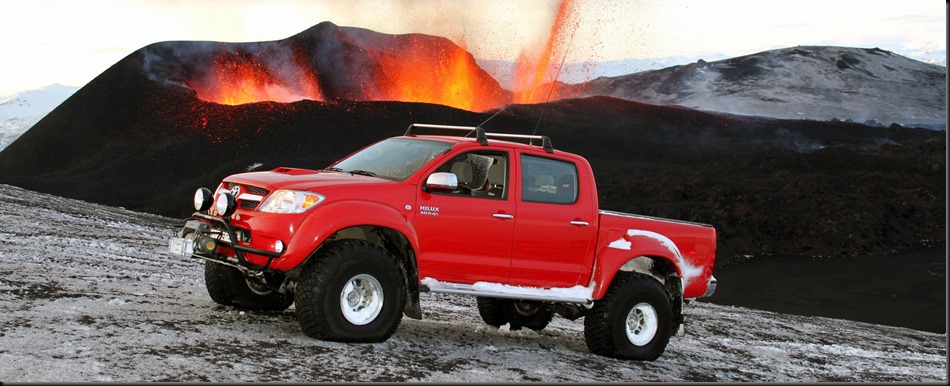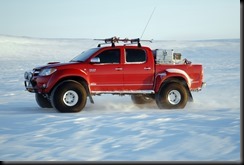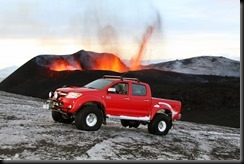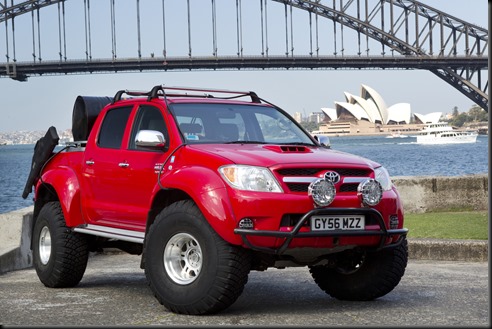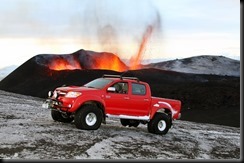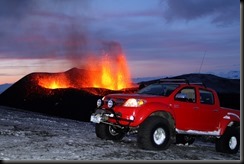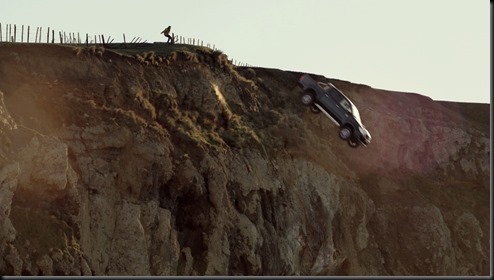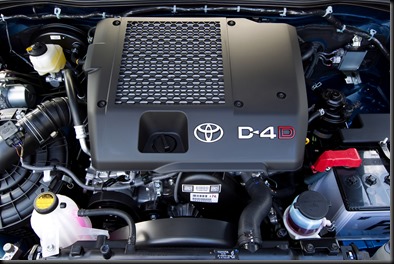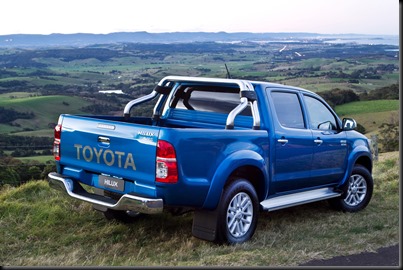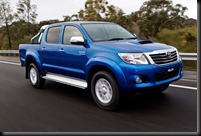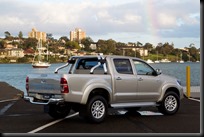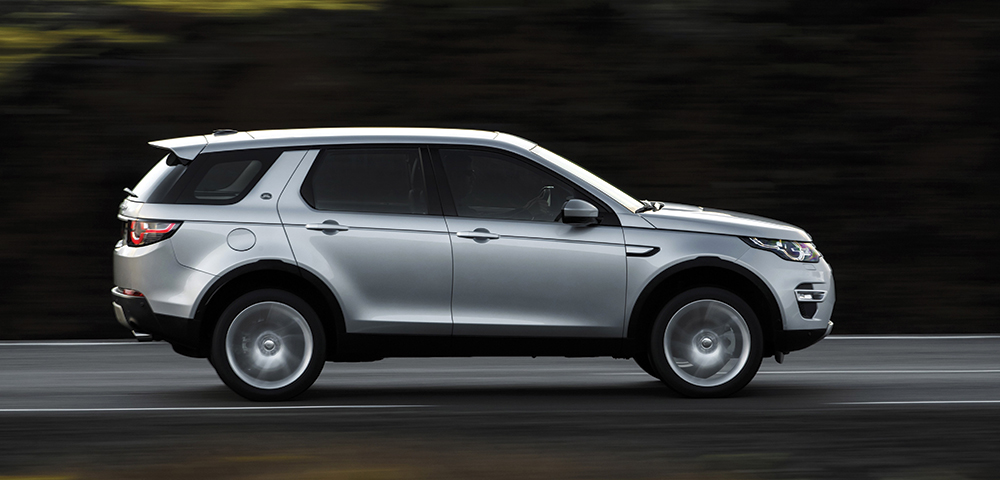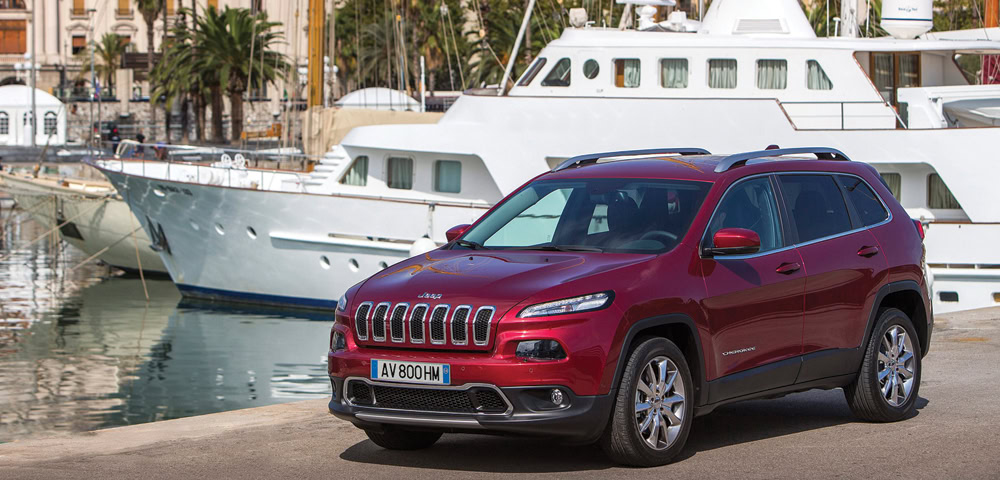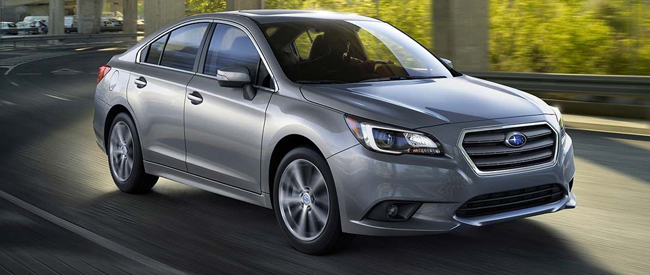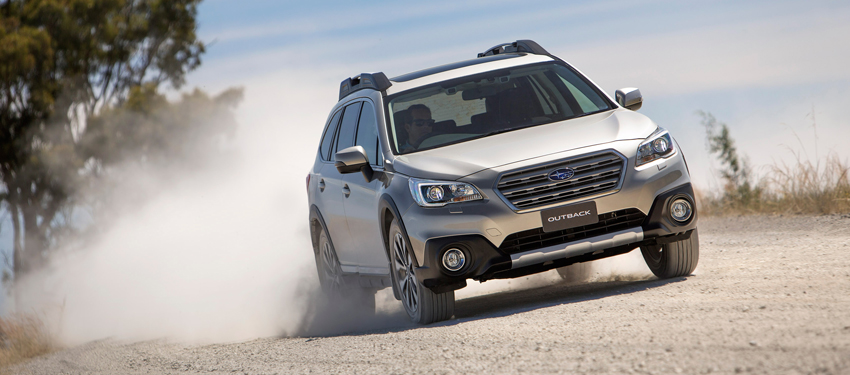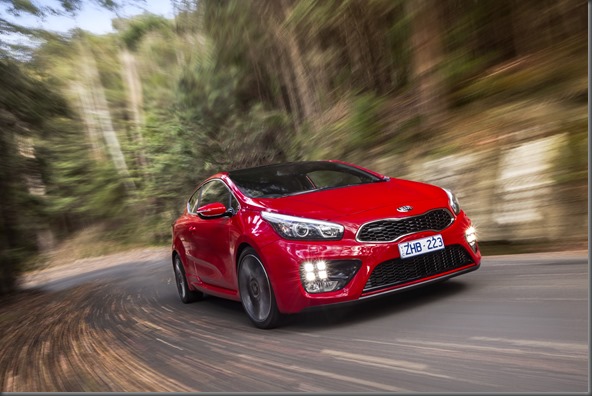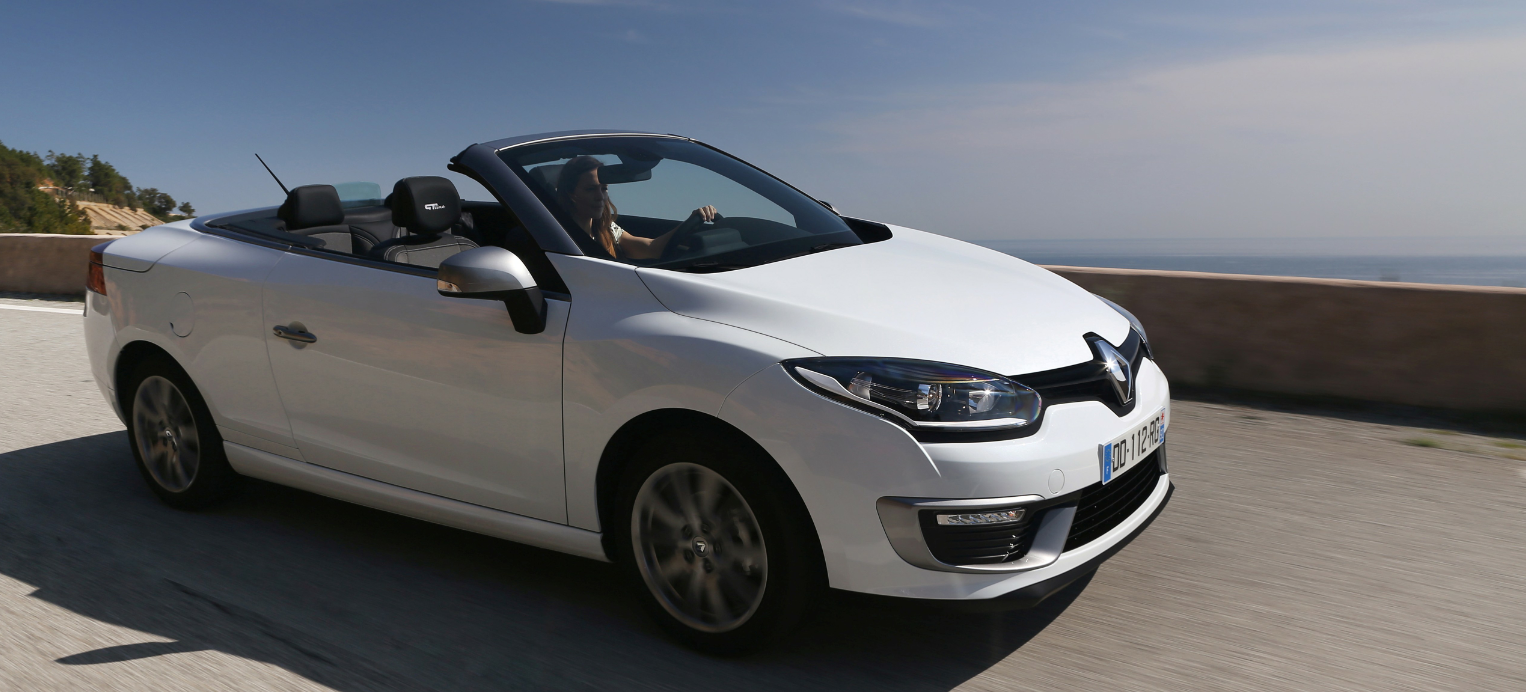
Eyjafjallajökull: Toyota HiLux did it, now try saying it
Toyota HiLux SR5: Leather and Shirtless Hunks Don’t Mix
Yes Yes Yes oh Yes: sexy, butch, versatile, well made, rugged, good reputation
Oh dear me no: pricey, noisy diesel, harsh ride, vague steering, limited rear legroom
Sexy, Muscular, Good-looking, Desirable, are all words I did not hear said about me during my week in the HiLux but the Ute itself got many kind comments.
When I think of HiLuxes, I think of the musky scent of sweaty “P” plated tradies with the merest hint of chest  hair peaking from an open flannelette shirt. I also think of loud music, beer and bad manners but there are always swings and roundabouts.. There is something sexy about a workman’s ute that you can’t quite put your finger on, but wish you could. Maybe it is the way it looks, or sounds, either way it evokes a feeling. They are honest and hardworking.
hair peaking from an open flannelette shirt. I also think of loud music, beer and bad manners but there are always swings and roundabouts.. There is something sexy about a workman’s ute that you can’t quite put your finger on, but wish you could. Maybe it is the way it looks, or sounds, either way it evokes a feeling. They are honest and hardworking.
The HiLux has been round for long enough that many are now slightly down-at-heel farm hacks and fisherman’s totes. Their prime is well and truly past, and they smell a little funky. It’s hard to believe they were once shiny and new.
The new HiLux is an evolution of that story. Strictly speaking it is a pick-up not a ute, but for our purposes Ute will do, this is Australia after all. I for one take great pleasure in thinking of “tradies” and “pick-up”, in the same sentence. I frequently need a short private moment after that notion has entered my thoughts, but I digress.
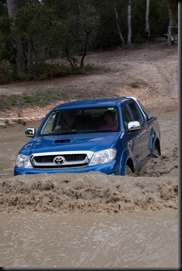 The HiLux is rugged and handsome and its interior feels sturdy and well made. There is a vague similarity with many other pick-up types, no matter who made them. After all you can’t go far wrong with a double cab and Ute back. All you need is an engine that doesn’t make a complete hack humping gear around a building site, a couple of chairs, and a nice interior with air conditioning. The top draw HiLux SR5 has either a 3.0L diesel or a 4.0 L petrol engine. The diesel has an adequate 126kw (@3600rpm)/343Nm (@1400rpm) but it won’t set the world on fire. The petrol has 175kw (@5300rpm)/376Nm (@3800rpm) and both need your stiletto mashed hard into the Axminster. Neither feel capable of moving with the tray full tool thingummies especially while towing a trailer, but, they do, and they do it well.
The HiLux is rugged and handsome and its interior feels sturdy and well made. There is a vague similarity with many other pick-up types, no matter who made them. After all you can’t go far wrong with a double cab and Ute back. All you need is an engine that doesn’t make a complete hack humping gear around a building site, a couple of chairs, and a nice interior with air conditioning. The top draw HiLux SR5 has either a 3.0L diesel or a 4.0 L petrol engine. The diesel has an adequate 126kw (@3600rpm)/343Nm (@1400rpm) but it won’t set the world on fire. The petrol has 175kw (@5300rpm)/376Nm (@3800rpm) and both need your stiletto mashed hard into the Axminster. Neither feel capable of moving with the tray full tool thingummies especially while towing a trailer, but, they do, and they do it well.
I mention this quite deliberately, because unladen, the diesel feels decidedly lack-lustre and is unbelievably noisy. Although it’s stupidly economical for a vehicle this size, I found myself not as in love as I thought I would be, given the whole tradie slant. There is only so far the musky-sweat fantasy will carry you.
The exterior is gorgeous. The side steps look great and they are handy for the vertically challenged amongst us. The stainless roll bars are only attached to the tray, so are purely decorative as they are on most utes. This makes no sense at all and would be no help in a rollover. You wouldn’t want to tie anything heavy to them either for fear of the whole thing coming away mid journey. Generally however, the appearance gets double snaps.
Inside, the cabin is understated and comfy. There are queens among us who will be particularly 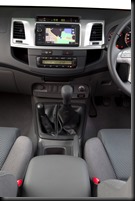 appreciative of the easy-wipe leather interior. They will like being able to give untimely spills a quick whisk over while keeping that nice leather smell as new. They are often found nose down giving it a really thorough inspection. Their enthusiasm and diligence is indeed laudable. Needless to say a genuine tradie probably wouldn’t be going for the leather option, even though at $60,000 the SR5 just sneaks in under the luxury car tax thresh hold.
appreciative of the easy-wipe leather interior. They will like being able to give untimely spills a quick whisk over while keeping that nice leather smell as new. They are often found nose down giving it a really thorough inspection. Their enthusiasm and diligence is indeed laudable. Needless to say a genuine tradie probably wouldn’t be going for the leather option, even though at $60,000 the SR5 just sneaks in under the luxury car tax thresh hold.
I have a theory: People should only be able to claim a car as a business expense and tax deduction if it is actually used for business. Those vehicles should be station wagons, utes, pick-ups, and vans under $60,000. Special dispensation may be sought if the business relates to 4WD’s such as off-roading tours and so forth. If people want luxury cars, they can pay for them themselves. If they don’t use them for business, why should it be a tax deduction? I’ve finished ranting now.
The dash is clearly laid out but the HiLux has an odd driving position. An average size driver needs to lean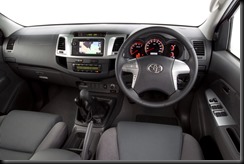 forward to reach dash mounted controls. With the seat set at a comfy reach to the pedals, the steering wheel won’t adjust high enough and has no adjustment for reach making it too low and too far away. It just isn’t quite right.
forward to reach dash mounted controls. With the seat set at a comfy reach to the pedals, the steering wheel won’t adjust high enough and has no adjustment for reach making it too low and too far away. It just isn’t quite right.
The Audio system is standard Toyota so has the ubiquitous Satnav and Bluetooth on the top model. It’s easy to use and sounds great, but I might expect more in a 60K car, albeit one that can tow a moon.
I like the hidey numerous holes, including under the back seats which are set slightly higher than the front. 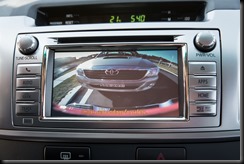 Herein lies another problem. Should you find yourself carting a bevy of safety-booted lads in the back for whatever reason, they will find they have no legroom. With the front seat set for me the rear legroom wasn’t overly generous, and was made worse by the height of the space between the front seats and the floor. Steel-capped boots won’t fit under the front seats, so the back seat boys have no room to move their feet. That is stupid in a tradies Ute which could logically expect blokes with work-boots on board.
Herein lies another problem. Should you find yourself carting a bevy of safety-booted lads in the back for whatever reason, they will find they have no legroom. With the front seat set for me the rear legroom wasn’t overly generous, and was made worse by the height of the space between the front seats and the floor. Steel-capped boots won’t fit under the front seats, so the back seat boys have no room to move their feet. That is stupid in a tradies Ute which could logically expect blokes with work-boots on board.
In the cargo hold, the tray needs a liner. You don’t want things rolling around in the back banging into things, do we? Speaking of banging, boys that bang nails in all week don’t want to bang things in on the weekend. Weekends are meant for play and the HiLux would be fabulous for campers. Your camping stuff would be tied into the tray with rope fixed with big butch knots. The only thing they’d be banging in would be tent pegs, probably.
Conclusion:
I wouldn’t want to drive the HiLux on a long trip. With the big off-road tyres the make the steering feel a little vague, and the wheel doesn’t adjust to where I’d feel comfortable. The ride is a bit harsh without a load in the back, and the rear leg room is far too limited, especially since you can’t get boots under the seat in front. The HiLux does what it does well, but the opposition like Amorok and Ranger are as good as the HiLux, and for similar trim levels are a bit cheaper.
Would I buy one? Sure, why not if I had a need for a tool carrier. I’d also have a look the Amorok and the Ranger.
Price: From $32,240 to $59,405 (*prices for Cab Chassis models not included **inc NSW onroads)
Engine (SR5 double cab diesel tested): 3.0L turbo diesel, 4cyl DOHC, 126KW/343Nm
